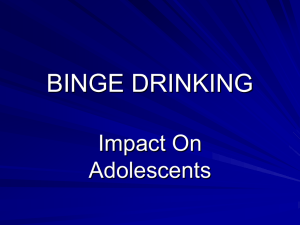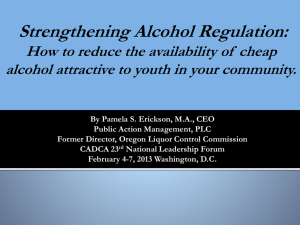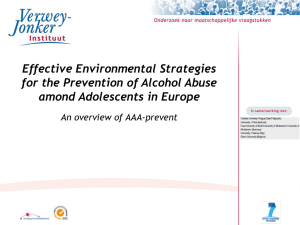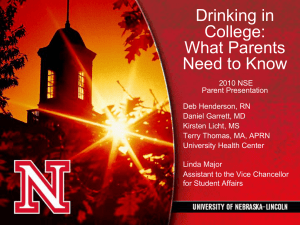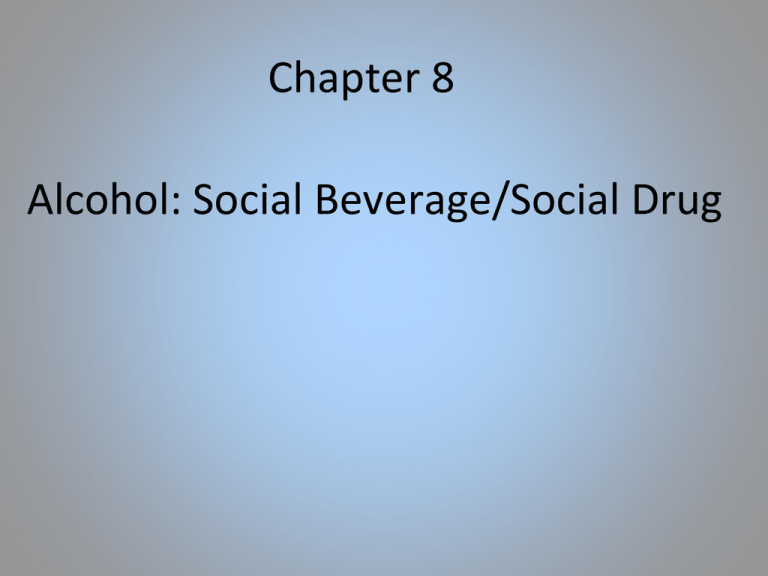
Chapter 8
Alcohol: Social Beverage/Social Drug
What Makes a Beverage
Alcoholic?
Fermentation of sugars by yeasts
honey (mead)
fruit (wine)
grain (beer)
alcoholic content limited to about 15%
Higher concentrations achieved by distillation
spirits
alcoholic content up to 95%
Table
8.1
Alcohol Use through History
Alcohol use dates back thousands of years
fermentation is very process simple
its discovery was probably accidental.
Distillation was perfected during the Middle Ages
brandy was the first distilled spirit
increases the alcohol content and preserves it
17th C
brandy was used to “fortify” wine
preserved it during shipping from Portugal to England
(Port)
Alcohol Use through History
In later centuries, gin gained popularity in Europe, as did
whiskey in the United States.
Serious concern about the adverse consequences of
alcohol consumption arose in the late 1700s and took
root in the United States as a temperance movement.
This movement addressed primarily the drinking of
distilled spirits.
The differentiation among forms of alcohol drinking
became blurred during the nineteenth century, as
temperance advocates began to promote a total ban on
alcohol consumption.
Alcohol Use through History
National Prohibition was the law in the United
States from 1920 to 1933.
Since the end of Prohibition, government regulation
has been carried out chiefly through education and
the taxation of alcohol.
Patterns of Alcohol
Consumption Today
The demographics of alcohol consumption reveal a large
disparity in the drinking habits of the population.
About a third do not drink at all, and only about 30
percent of those who drink account for 80 percent of all
the alcoholic beverages consumed in the United States.
Peak alcohol consumption occurs at ages twenty-one to
twenty-two.
Past-Month Adolescent Alcohol, Cigarette, and
Marijuana Use by Grade.
Source: Data from 2006 Monitoring the Future Survey
Percentage of Americans Who Have Ever Drunk Alcohol (A
Whole Drink).
Source: SAMHSA data from 2005 National Survey on
Drug Use and Health (NSDUH)
Number of Days in the Past 30 in Which Drinkers Consumed 5
or More Drinks, by Age and Gender.
Source: SAMHSA data from 2005 NSDUH
Binge drinking increases short-term risks (accident, overdose, etc)
The Pharmacology of Alcohol
Alcohol is a very small molecule, easily soluble in both
water and fat.
Its absorption into the bloodstream is extremely
rapid.
The breakdown of alcohol is handled by two enzymes
in the stomach and especially in the liver, alcohol
dehydrogenase and acetaldehyde dehydrogenase.
metabolism by liver, in GI tract
metabolism by brain
legal limit 0.08%, or 80 mg%
Blood alcohol concentration (BAC) after the rapid consumption of different amounts
of alcohol by eight adult fasting male subjects.* (Adapted from Wilkinson et al.,
Journal of Pharmacokinetics and Biopharmaceutics, 5(3):207-224, 1977.)
The Pharmacology of Alcohol
The rate of alcohol biodegradation is constant
(~100mg/hr/kg) and dependent on the activity of alcohol
dehydrogenase, which limits the rate of metabolism and
excretion no matter what quantity of alcohol is consumed.
The level of alcohol in the body is measured by the bloodalcohol concentration (BAC; ml/dl), which is dependent on
body weight, rate of consumption and time since the last
drink.
Table 8.2
The Pharmacology of Alcohol
Blood alcohol tests are impractical as part of a field
sobriety test, so breath alcohol concentration (BrAC) is
used instead (Breathalyzer).
BAC is estimated from BrAC using a partition ratio
(BAC:BrAC) of 2100:1.
Urinalysis is another non-invasive way to estimate BAC,
but is most useful for long-term detection of ethanol
consumption. Ethyl gluturonide (EtG) is detectable for
several days since ingesting alcohol.
Effects of Alcohol
on the Brain
Although alcohol affects
several neurotransmitters in
the brain, it is presently agreed
that the principal effect is
stimulation of the GABA
receptor.
Alcohol also acts as an indirect antagonist at NMDA
receptors, and thus shares some actions with PCP and
ketamine.
Effects of Alcohol
on the Brain
Generally, the neural effect of alcohol begins with inhibition
of the cerebral cortex, then that of lower brain regions.
Alcohol exerts a powerful effect on the cerebellum via
its GABA agonistic effects. Cerebellar function is the
primary target of behavioral field sobriety tests.
Effects of Alcohol
on the Brain
Inhibition of respiratory systems in the medulla,
usually accomplished at BAC levels in the
neighborhood of 0.50 percent, results in
asphyxiation and death.
Acute Physiological Effects
loss of body heat (peripheral vasodilation)
increased excretion of water
increased heart rate
constriction of coronary arteries
disturbed sleep
serious interactions with other drugs.
Acute Behavioral Effects
exhilaration and excitement
talkativeness
slurred speech
loss of coordination
irritability
aggressiveness
drowsiness
sensorimotor impairment
impaired judgment
Adolescents Often Get Alcohol From
Adults
40% of underage drinkers
ages 12 to 20,who drank in the past 30 days
obtained alcohol at no cost from adults 21 or older
> 6% of underage drinkers
given alcohol by their parents in the past month
The younger the underage drinker, the more likely he or
she is to get alcohol from a family member
> 30% of 12 to 14 year old drinkers get alcohol from
a family member
12% of drinkers age 18 to 20
Risks Associated with Underage
Binge Drinking
High school students in the U.S. who binge drink
frequently are at higher risk for the following outcomes
than are students who abstain from drinking:
Risky Sexual Behavior
Assaults
Sexual Assaults
Injuries
Academic Problems
Legal Problems
However, no causal connections have been established
between all of these outcomes and binge drinking
Alcohol-related Fatalities Among
Underage Drinkers
Motor Vehicle Crashes: About 1,900 deaths
Homicides: About 1,600 deaths
Suicides: About 300 deaths
Alcohol Consumption and Binge
Drinking are Common Among
College Students
Alcohol Consumption: About four in five of all college
students drink, including nearly 60 percent of students
ages 18 to 20.
Binge Drinking: Approximately two of every five college
students of all ages—more than 40 percent—have
reported engaging in binge drinking at least once during
the past 2 weeks. However, colleges vary widely in their
binge drinking rates—from 1 percent to more than 70
percent (Wechsler et al., 1994, 1998, 2000b and NSDUH
2006).
Excessive Drinking in College (ages
18-24) Leads to Many Adverse
Outcomes: Accidents
599,000 students are unintentionally injured under the
influence of alcohol each year
(about half are students under 21)
of those, about 1,700 die each year including those in
motor vehicle crashes
(about half among students under 21)
Excessive Drinking in College (ages
18-24) Leads to Many Adverse
Outcomes: Interpersonal
696,000 are assaulted by another student who has been
drinking each year
(430,000 by a college student under 21)
97,000 are victims of alcohol-related sexual assault or date
rape each year
(about half among students under 21)
400,000 had unprotected sex as a result of their drinking
>100,000 students were too intoxicated to know if
they consented to having sex
Excessive Drinking in College (ages
18-24) Leads to Many Adverse
Outcomes: Other Events
About 25 percent report academic consequences of their
drinking
missing class
falling behind
doing poorly on exams or papers
receiving lower grades overall
About 11 percent of drinkers report that they have
vandalized property while under the influence of alcohol
The Adolescent Brain May be
Particularly Vulnerable to the Effects
of Alcohol
Reactions to Alcohol:
Animal Studies:
adolescent animals are less sensitive than adults to
some of the aversive effects of acute alcohol intoxication
e.g. sedation, hangovers, and loss of coordination
more sensitive to alcohol’s effects on social facilitation
may enjoy the positive sensations more than adults
experience fewer of the immediate negative effects
that often serve as protective factors for older
drinkers.
The Adolescent Brain May be
Particularly Vulnerable to the Effects
of Alcohol
Risk-taking:
less mature frontal lobes may be more sensitive to
the effects of alcohol
greater deficits in
self regulation
judgment
reasoning
problem solving
impulse control
impulsive decisions or actions without regard for
consequences can put teenagers at serious risk.
Social/Environmental Factors
Influence Underage Drinking
Risk and protective factors for alcohol use shift
throughout adolescence.
Transitions: moving from elementary to middle and middle
to high school may present increased risk for alcohol use
Stress: Increased stress may lead to alcohol use
Personality traits: Youth with the following characteristics
are more likely to consume alcohol than are others
Strong desires for new experiences and sensations
History of behavior problems
Family conflict and/or familial alcohol problems
Binge Drinking Among Adolescents
is a Global Problem
The percentage of 15-16 year old students who
report drinking to intoxication is higher than in the U.S.
in most European countries
Italy, France, and Greece are among European
countries in which a smaller proportion of students
report having been drunk 10 times or more during the
past 12 months than do those in the U.S.
Acute Behavioral Effects
serious adverse behavioral effects include
blackouts
significant impairment in attention, judgment and
sensorimotor skills
increased potential for aggressive or violent acts
Other behavioral effects?
Why do people (adults over the legal age) drink?
Table 8.4
Acute Behavioral Effects
Particular attention has been directed toward these
problems within a college student population.
The relationship between alcohol consumption and
sexual desire and performance is a complex one, with
differences being observed for men and women.
Table 8.3 Alcohol/drug interactions
Alcohol and Health Benefits
The accumulated evidence of medical research has
indicated that there is a reduced risk for coronary heart
disease and stroke with moderate consumption of
alcohol.
Possible health benefits include a reduction of risk for
diabetes, dementia, and rheumatoid arthritis.
Alcohol and Health Benefits
Moderate alcohol consumption has been defined as no
more than one drink per day for women and no more
than two drinks per day for men.
There should be zero tolerance for alcohol consumption
among pregnant women.
Strategies for Responsible
Drinking
Despite the potential for alcohol consumption to
produce adverse effects, most people can drink
alcohol in a responsible way that avoids these
harmful consequences.
However, the risk of alcohol dependence is always
present.
Strategies for Responsible
Drinking
keep track of your consumption
drink low-alcoholic beverages (beer, wine)
know what you are drinking
drink slowly (e.g. alternating alcohol & water)
avoid bingeing
eat before/while drinking
avoid salt (makes you thirstier)
take time to taste what you are drinking
drink socially rather than alone
don’t drink and drive
make drinking an adjunct to other activities


